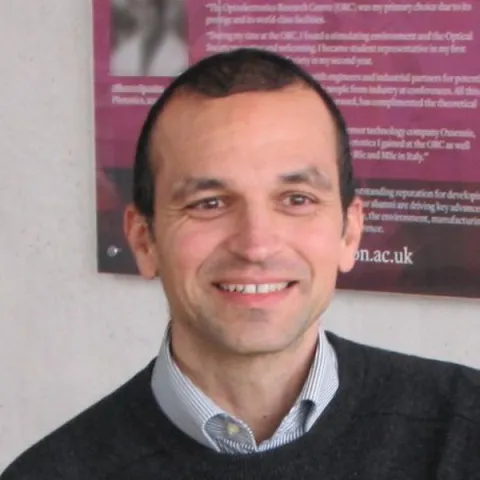Project overview
The National Dark Fibre Facility (NDFF - https://www.ndff.ac.uk/) provides the UK National Research Facility for dark fibre network research. A dark fibre network is a communications network, where it is possible to access and control the network at the optical layer, Layer1 (physical layer) in the seven layer Open Systems Interconnection (OSI) model of communications networks which underpins the internet. NDFF is a new, fully remotely configurable, flexible and high capacity research facility, building upon the success of the National Dark Fibre Infrastructure Service (NDFIS1) dark fibre network (2013-2018). It allows UK universities and their industrial collaborators to develop and demonstrate future networks which require access to or control of the optical layer (OSI Layer1).
NDFF comprises:
1. A dark fibre network of scale sufficient for experiments representative of real-world applications (>850 km). Users are able to connect their equipment directly to the installed fibres and control the optical layer, allowing experiments on new techniques, such as quantum encoded data, adaptive spectrum slicing and Software Defined Networks (SDN).
2. User experiment areas at multiple access nodes to interface directly with NDFF dark fibre. Interconnection for traffic generation and experiment control is also possible UK-wide at Layer2 through services such as Janet Netpath.
3. Remotely programmable amplifiers, switches and dispersion compensation modules which enable the transmission characteristics of the network to be varied and allow dynamic configuration of the network topology by users.
4. Wavelength Selective Switches (WSS) to split optical channels into separate optical fibres (or merge them into one fibre). A Flexgrid WSS gives user defined channel widths, enabling research on new utilisation models for the optical spectrum, increasing available logical topologies and allowing concurrent experiments using different optical wavelengths.
5. A remotely configurable Layer2 and above network to enable research into dynamic and intelligent network management.
6. An SDN and Network Function Virtualisation (NFV) research platform for UK researchers, enabling them to upload network policies directly, monitoring and manipulating the optical properties of the network. UK researchers are able to develop and test networks having optimised latency, traffic grooming, energy consumption or security properties.
7. A distributed processing infrastructure by linking sites that host servers, storage, memory and sensing. This provides opportunities to study distributed Cloud and Fog infrastructures connected by high-capacity reconfigurable optical networks. It also provides nerve nodes that can perform network analytics offering users a new level of network programmability and adaptation.
8. The ability to test concepts in network security and resilience across all seven OSI model layers, something that is impossible with other networks. This is of particular importance as networks are starting to introduce software control and flexibility at Layer1, creating new security and resilience challenges for network control.
9. Training using dedicated research and technician support. Administration, user interface and dissemination are the responsibility of a dedicated facility manager. In order to achieve the full potential of the facility, it is crucial to engage with the UK research community and promote the service. NDFF engages in UK and international meetings and brings together users at an annual user day. Web-based interfaces with users and potential users will be further developed.
The NDFF links four universities sites, UCL, Bristol, Cambridge and Southampton, with onward connection to European and Worldwide research networks via telecommunications facilities in London. Its Director is Professor Alwyn Seeds (University College London).
NDFF comprises:
1. A dark fibre network of scale sufficient for experiments representative of real-world applications (>850 km). Users are able to connect their equipment directly to the installed fibres and control the optical layer, allowing experiments on new techniques, such as quantum encoded data, adaptive spectrum slicing and Software Defined Networks (SDN).
2. User experiment areas at multiple access nodes to interface directly with NDFF dark fibre. Interconnection for traffic generation and experiment control is also possible UK-wide at Layer2 through services such as Janet Netpath.
3. Remotely programmable amplifiers, switches and dispersion compensation modules which enable the transmission characteristics of the network to be varied and allow dynamic configuration of the network topology by users.
4. Wavelength Selective Switches (WSS) to split optical channels into separate optical fibres (or merge them into one fibre). A Flexgrid WSS gives user defined channel widths, enabling research on new utilisation models for the optical spectrum, increasing available logical topologies and allowing concurrent experiments using different optical wavelengths.
5. A remotely configurable Layer2 and above network to enable research into dynamic and intelligent network management.
6. An SDN and Network Function Virtualisation (NFV) research platform for UK researchers, enabling them to upload network policies directly, monitoring and manipulating the optical properties of the network. UK researchers are able to develop and test networks having optimised latency, traffic grooming, energy consumption or security properties.
7. A distributed processing infrastructure by linking sites that host servers, storage, memory and sensing. This provides opportunities to study distributed Cloud and Fog infrastructures connected by high-capacity reconfigurable optical networks. It also provides nerve nodes that can perform network analytics offering users a new level of network programmability and adaptation.
8. The ability to test concepts in network security and resilience across all seven OSI model layers, something that is impossible with other networks. This is of particular importance as networks are starting to introduce software control and flexibility at Layer1, creating new security and resilience challenges for network control.
9. Training using dedicated research and technician support. Administration, user interface and dissemination are the responsibility of a dedicated facility manager. In order to achieve the full potential of the facility, it is crucial to engage with the UK research community and promote the service. NDFF engages in UK and international meetings and brings together users at an annual user day. Web-based interfaces with users and potential users will be further developed.
The NDFF links four universities sites, UCL, Bristol, Cambridge and Southampton, with onward connection to European and Worldwide research networks via telecommunications facilities in London. Its Director is Professor Alwyn Seeds (University College London).
